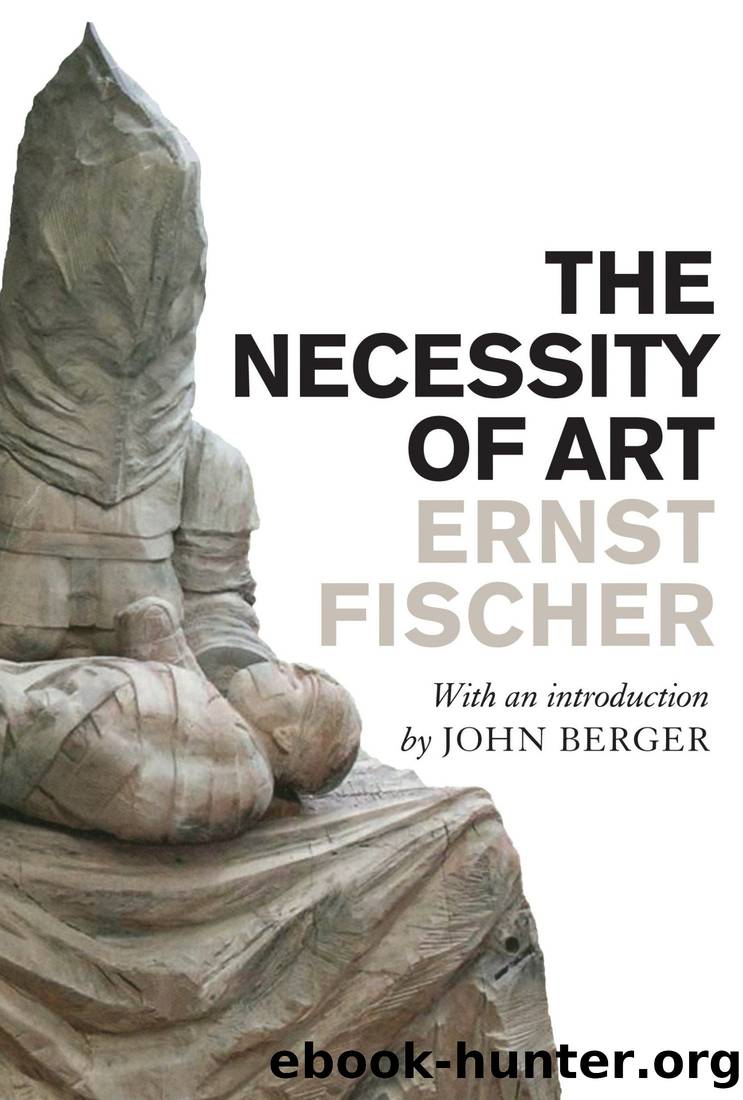The Necessity of Art by Ernst Fischer

Author:Ernst Fischer [Fischer, Ernst]
Language: eng
Format: mobi, epub
Published: 0101-01-01T00:00:00+00:00
Crystals
Crystals are thought to possess the most perfect form in all inorganic nature. Looking at those marvellously ordered, transparently radiant formations, contemplating their fascinating regularity, admiring their austere beauty, one might indeed come to think that in them inorganic matter has, as it were, become spiritual by attaining a flawless perfection. A naïve, unscientific observer might be tempted to regard them as the works of art of a creative Nature or of a divine Creative Force. That is to say, he might well read something intentional or deliberate into them. This temptation is all the greater as the beauty-lover's attention is not centred upon the crystalline structure of all solids, which is often quite undistinguished, but only upon a small élite of particularly ânobleâ crystals. And so we are told by some modern disciples of scholasticism that crystals are âthe embodiment of mathematics,â that the structure of the atom is âimmaterialâ to the crystal, that symmetry is not due to the properties of the atoms of which a crystal is formed but to a non-material, metaphysical crystalline lattice, that the crystalline lattice is âbeyond substance,â that it represents the âformative order principle,â and that form is present as an âidea,â a âwish for perfectionâ in every crystal. The substance is, they tell us, âconsumedâ by the crystal; the perfect crystal represents the âidealâ crystal as purely as this is possible in reality; it is really completely homogeneous, outwardly a clear form, inwardly a differentiated unity', in which atoms are contained only as a âpotentialityâ but not as a reality. Does this metaphysical view correspond to the truth? Is inorganic nature really subject to an autocratic âformal principleâ? Does form really make the crystal? Or is the crystalline form determined by atoms of matter having their own specific properties?
It would go far beyond the scope of this book to re-state the findings of modern crystallography with any degree of completeness. We must confine ourselves to a few characteristic examples;· First : the structure of the atoms of which a crystal is composed, far from being immaterial to the structure of the crystal, actually determines it. Crystallographers today are often able to predict the crystalline structure of a given chemical compound on the basis of the properties of its atoms. Let us take the diamond, that radiant apotheosis of carbon which is the strangest and most versatile of all the elements . The structure of the diamond, in which each carbon atom is tetrahedrally surrounded by four adjoining atoms, corresponds exactly to the structure of carbon with its four valency electrons. In other cases, too, the molecular grouping of atoms has been experimentally proved to apply to crystals. The crystal may be regarded as a molecule which is, in principle, infinite, or conversely the molecule may be regarded as a crystal. Further: it is by no means a metaphysically predetermined space lattice that assigns to each atom its place in the crystal in order then to transform it into pure âpotentiality,â or unreality.
Download
This site does not store any files on its server. We only index and link to content provided by other sites. Please contact the content providers to delete copyright contents if any and email us, we'll remove relevant links or contents immediately.
The Japanese by Christopher Harding(1084)
Watercolor With Me in the Forest by Dana Fox(751)
A Theory of Narrative Drawing by Simon Grennan(742)
The Story of the Scrolls by The Story of the Scrolls; the M(725)
Glittering Images: A Journey Through Art From Egypt to Star Wars by Camille Paglia(717)
Boris Johnson by Tom Bower(620)
This Is Modern Art by Kevin Coval(597)
The Art and Science of Drawing by Brent Eviston(588)
Frida Kahlo by Frida Kahlo & Hayden Herrera(584)
AP Art History by John B. Nici(574)
Banksy by Will Ellsworth-Jones(569)
War Paint by Woodhead Lindy(549)
Van Gogh by Gregory White Smith(547)
Draw More Furries by Jared Hodges(544)
About Looking by John Berger(543)
Scenes From a Revolution by Mark Harris(542)
Ecstasy by Eisner.;(535)
100 Greatest Country Artists by Hal Leonard Corp(523)
Young Rembrandt: A Biography by Onno Blom(512)
